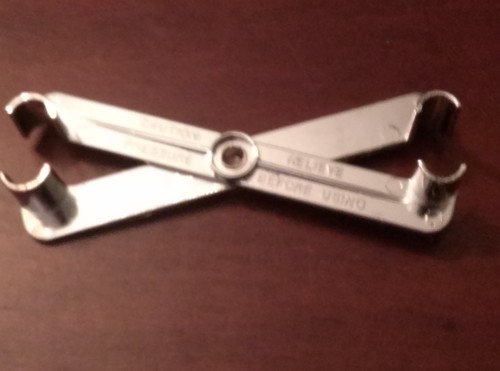Fuel Line Wont Disconnect
Having trouble disconnecting your fuel line? Ensure there are no obstructions or debris preventing separation.
If difficulties persist, consult a professional for assistance. Struggling with disconnecting your fuel line can be a frustrating experience, especially when you’re unsure of the cause. Issues with the connection can stem from various factors such as dirt, rust, or improper alignment.
This guide will provide you with practical steps and tips for addressing a stubborn fuel line that you can troubleshoot yourself. By following these instructions, you can quickly resolve the problem and resume your work with minimal hassle. Let’s dive into the solutions to effectively disconnect your fuel line and get your vehicle back on track.

Credit: www.impalassforum.com
Common Causes
When your fuel line won’t disconnect, it can be a frustrating and potentially dangerous issue to deal with. There are several common causes that can lead to this problem, including:
Rust And Corrosion
Rust and corrosion in the fuel line fittings can cause them to become stuck or difficult to disconnect. Over time, exposure to moisture and environmental elements can lead to the buildup of rust and corrosion, hindering the smooth disconnection of fuel lines.
Mismatched Fittings
Using fittings that are not compatible with each other can result in difficulty disconnecting the fuel lines. When fittings are mismatched, they may not align properly, leading to resistance and difficulty in disconnecting the fuel lines.
Excessive Fuel Pressure
Excessive fuel pressure within the system can create a situation where the fuel line fittings are tightly sealed, making it challenging to disconnect them. High pressure can cause the fittings to become seized, requiring extra force to disconnect the fuel lines.

Credit: www.reddit.com
Tools And Supplies
When working on a fuel line that won’t disconnect, having the right tools and supplies is crucial.
Socket Wrench
- A socket wrench with the appropriate size socket will help loosen any stubborn fittings.
Pliers
- Pliers may be needed to grab onto small components that are difficult to reach.
Thread Sealant
- Applying thread sealant to the fittings before reassembly can prevent leaks.
Step-by-step Procedure
Step-by-Step Procedure:
Prepare The Work Area
Clear the surrounding space for easy access.
- Gather necessary tools: safety glasses, gloves.
- Ensure proper ventilation in the work area.
Release Fuel Pressure
Prevent any accidents during the disconnection.
- Locate the fuel pump fuse or relay.
- Start the engine and let it idle until it stops.
- Turn off the engine and remove the fuse or relay.
Disconnect The Fuel Line
Ensure a safe and effective disconnect.
- Identify the fuel line connection point.
- Press the quick disconnect tabs firmly.
- Pull the fuel line apart gently.
Safety Precautions
Safety precautions must be taken when dealing with a fuel line that won’t disconnect. Proper handling and caution are necessary to prevent accidents or damage to the fuel system.
Wear Safety Gloves
“` Always put on durable and chemical-resistant safety gloves before handling fuel line components. This simple step can effectively protect your hands from potential fuel contact and minimize the risk of injury. “`htmlWork In A Well-ventilated Area
“` Ensure that your work area is adequately ventilated to reduce the risk of inhaling harmful fumes. This precautionary measure is vital for maintaining a safe and healthy environment while working on fuel lines. “`htmlAvoid Smoking Or Open Flames
“` To prevent the possibility of ignition, it is imperative to refrain from smoking or having open flames in the vicinity of fuel line work. This simple yet crucial measure can significantly reduce the risk of accidents and ensure a safe working environment.Seek Professional Help
When dealing with fuel line issues, it’s important to know your limits. While you may be capable of troubleshooting and fixing some minor problems with your vehicle, complex fuel system issues require the expertise of a professional. Attempting to disconnect a fuel line without proper knowledge and experience can lead to serious consequences, including personal injury and damage to your vehicle.
When In Doubt
If you have any doubts or uncertainty about disconnecting a fuel line, it’s always best to seek professional help. Fuel systems are intricate and delicate, and if not handled correctly, can cause leaks, pressure build-ups, or even fires. With the potential dangers involved, it’s better to be safe than sorry. Trusting a trained mechanic or technician to handle the job ensures that the fuel line will be disconnected properly, minimizing the risks involved.
Complex Fuel Systems
Modern vehicles have advanced fuel systems that are far more complex than those in older models. With the advent of fuel injection systems and the integration of electronics, fuel systems have become highly intricate and interconnected. This complexity can make it difficult for even seasoned DIY enthusiasts to navigate. Fuel lines may be hidden or hard to access, requiring specialized tools and knowledge to safely disconnect them.
Trying to disassemble or disconnect these complex fuel systems without proper guidance can lead to costly mistakes. One wrong move can damage the fuel line, injectors, or other sensitive components, resulting in expensive repairs. Additionally, tampering with such systems can void your vehicle’s warranty. So, it’s crucial to seek the assistance of a professional who understands the inner workings of your specific make and model.
In conclusion, while it may be tempting to tackle fuel line issues on your own, seeking professional help is the wisest choice when dealing with complex fuel systems. Trusting an expert ensures the job is done correctly, minimizing the risk of accidents and costly damage in the long run.

Credit: www.reddit.com
Frequently Asked Questions On Fuel Line Wont Disconnect
How Do You Remove A Stuck Fuel Line?
Using a penetrating lubricant, spray around the connection and let it sit. Gently wiggle the fuel line to loosen it. If still stuck, use a heat gun to heat the area. Be cautious not to overheat. Once loosened, carefully disconnect the fuel line.
How Do You Disconnect A Fuel Line?
To disconnect a fuel line, first locate the connection. Use a fuel line disconnect tool to separate the fittings. Be cautious of any fuel spills during the process.
How Do I Make A Homemade Fuel Line Disconnect Tool?
To make a homemade fuel line disconnect tool, cut a metal coat hanger and bend it into a U-shape. Insert it into the fuel line to release the tabs and disconnect it easily.
What Tool Is Used To Disconnect Fuel Lines?
You can use a fuel line disconnect tool to disconnect fuel lines.
Why Is My Fuel Line Not Disconnecting?
There could be several reasons why your fuel line is not disconnecting, such as a faulty release button, worn out connectors, or fuel pressure still in the line.
How Do I Fix A Fuel Line That Won’t Disconnect?
To fix a fuel line that won’t disconnect, try applying penetrating oil, gently wiggling the line, or using a fuel line disconnect tool.
Can I Disconnect A Fuel Line Without Releasing The Pressure?
It is not recommended to disconnect a fuel line without releasing the pressure, as it can be dangerous and lead to fuel spraying. Always ensure the pressure is released first.
Conclusion
Dealing with a fuel line that won’t disconnect can be frustrating. By carefully following the steps outlined in this blog post, you can safely troubleshoot and resolve the issue. Remember to prioritize safety and seek professional assistance if needed. With patience and the right tools, you can successfully manage this common vehicle maintenance task.
